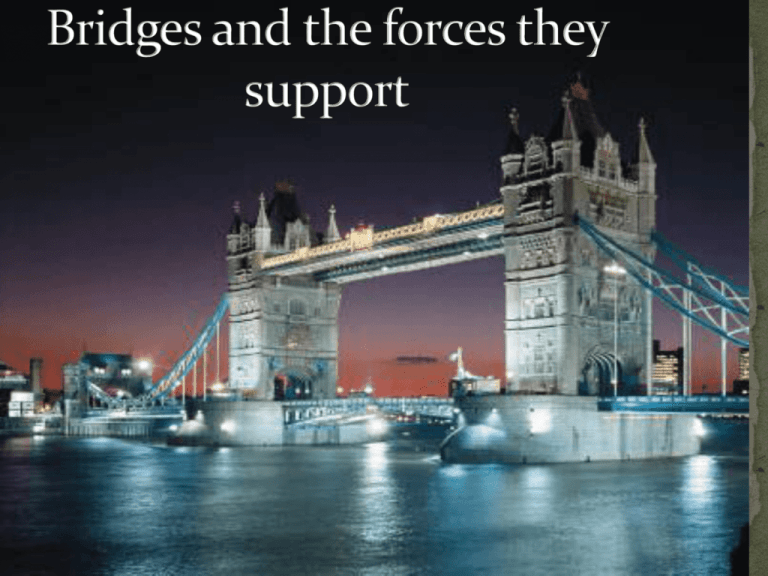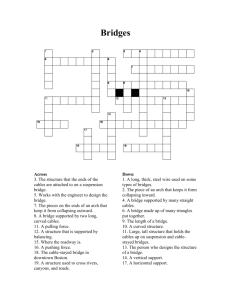Bridges and the forces they support
advertisement

A swinging cable and wooden plank bridge in a New Zealand rain forest. The many bridges in New York City make transportation possible for a huge population Currently the state of Colorado has more than 8,000 bridges The U.S. has more than 500,000 bridges that are more than 100 feet (30 m) long! Compression is a force that acts to compress or shorten the thing it is acting on. Tension is a force that acts to expand or lengthen the thing it is acting on. The job of engineers to design bridges capable of withstanding these forces without buckling or snapping. Buckling occurs when compressive forces overcome an object's ability to handle compression Snapping occurs when the tensile forces overcome an object's ability to handle tension. Tensile and compressive forces acting on a beam bridge; in a typical beam bridge tensile forces are negligible. Compressive forces are indicated by red arrows and tensile forces are indicated by blue arrows. Dissipate force is to spread it out over a greater area, so that no one spot has to bear the brunt of the concentrated force. Transfer force is to move it from an area of weakness to an area of strength, an area designed to handle the force. An arch bridge is a good example of dissipation, while a suspension bridge is a good example of transference Tension and compression forces acting on an arch bridge (left) and suspension bridge (right). Compressive forces are indicated by red arrows and tensile forces are indicated by blue arrows. Beam (or truss)Bridge Typical span lengths are: up to 200 feet Arch Bridge Typical span lengths are: 130-500 feet Suspension Bridge Typical span lengths are: 2,000-7,000 feet Typically a simple structure made of horizontal, rigid beams. The beam ends rest on piers or columns. The weight of the beams (and any other load) is supported by the piers or columns. Compression force acts on the top portion of the beam and bridge deck, shortening these two elements. Tension force acts on the bottom portion of the beam, stretching this element An arch bridge is easily recognized with its defining characteristic of a semicircular structure. Not as easily recognized but extremely important are the abutments at each end of the semicircular arch. Compression force acts outward along the curve of the arch and into the abutments Tension force acts on are small in most arches and usually negligible. Conventional suspension bridges are recognized by the elongated M shape. In these bridges, parallel sets of large cables are suspended between at least two towers (with smaller cables hung vertically from the large cable) and anchor into the earth at their end points. The smaller cables support the roadway. The weight of the bridge deck and any additional load push down on the bridge deck and create a force of tension in the cables. The cables then transfer their force to the towers. The force induced in the towers is compressive; the towers dissipate this force to the earth. Beam bridges are the most common type of bridges, and include truss bridges. Truss bridges distribute forces differently than other beam bridges and are often used for heavy car and railroad traffic. In a truss bridge, the beams are substituted by simple trusses, or triangular units, that use fewer materials and are simple to build. Today, we are going to act as teams of engineers making bridge models. We have been hired by a city to create a bridge to cross one of the local rivers. However, the city does not want the bridge to affect the fish population in the river below it. Engineers always consider their "design objective" when creating their models. Make a bridge that spans the river (scaled down to a distance of 10 inches [25 cm] Supports the most weight for the cars that will pass over it Does not disturb the river's fish. To simulate the load of the cars, our bridge must have a place to securely hold a small cup in the center of the span. To demonstrate environmental limitations on the design, no part of the bridge may touch the "water" (or bottom of the wooden support structure) Cannot be taped to the wooden support structure. 1) Developing a complete understanding of the problem 2) Determining potential bridge loads 3) Combining these loads to determine the highest potential load 4) Computing mathematical relationships to determine the how much of a particular material is needed to resist the highest load. Determining the potential loads or forces that are anticipated to act on a bridge is related to the bridge location and purpose. Engineers consider three main types of loads: Dead loads include the weight of the bridge itself plus any other permanent object affixed to the bridge, such as toll booths, highway signs, guardrails, gates or a concrete road surface. Live loads are temporary loads that act on a bridge, such as cars, trucks, trains or pedestrians. Environmental loads are temporary loads that act on a bridge and that are due to weather or other environmental influences, such as wind from hurricanes, tornadoes or high gusts; snow; and earthquakes. Rainwater collecting might also be a factor if proper drainage is not provided. During bridge design, combining the loads for a particular bridge is an important step. Engineers use several methods to accomplish this task. The two most popular methods are the UBC and ASCE methods. 1. Dead Load + Live Load + Snow Load 2. Dead Load + Live Load + Wind Load (Earthquake Load) 3. Dead Load + Live Load + Wind Load + (Snow Load ÷ 2) 4. Dead Load + Live Load + Snow Load + (Wind Load ÷ 2) 5. Dead Load + Live Load + Snow Load + Earthquake Load




